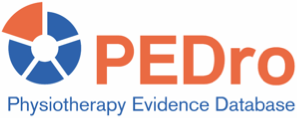Musculoskeletal pain is prevalent, disabling and associated with high socioeconomic costs. In the 2000’s there was a paradigm shift in using education to treat musculoskeletal pain. Traditional education strategies focused on anatomy, biomechanics and the biomedical model for pain (eg, back schools). The contemporary pain neurophysiology (or neuroscience) education model focused on increasing knowledge of pain, the nervous system and the factors modulating pain to reconceptualise pain, including that experiencing pain often relates to hypersensitivity of the nervous system rather than tissue damage. This systematic review aimed to estimate the effects of pain neurophysiology education compared to control on pain, disability and psychological distress in people with musculoskeletal pain.
Guided by a protocol, sensitive searches in seven databases (including Medline, Embase and Cochrane CENTRAL), citation tracking and contacting experts were conducted to identify randomised controlled trials evaluating pain neurophysiology education in people with musculoskeletal pain. Trials recruiting adults with acute or chronic musculoskeletal pain in any body part (spinal or in the extremities) were included. All forms and durations of pain neurophysiology education were accepted (group- or individual-based delivered in person or via other media in isolation or as part of an intervention program). Any intervention or control condition that did not involve pain neurophysiology education could be used as a comparator. The main outcomes were pain intensity, disability and psychological distress (hierarchy of outcomes were Pain Catastrophising Scale, Tampa Scale of Kinesiophobia then other composite scores) measured immediately post-intervention and in the long-term (about 1 year after intervention). Adverse events were also investigated. Two reviewers independently selected trials for inclusion, extracted data and evaluated trial quality and certainty of evidence. Any disagreements were resolved through discussion or by arbitration from a third reviewer. Trial quality was evaluated using the Cochrane risk of bias tool (version 2.0). Certainty of evidence was evaluated using the Grading of Recommendations Assessment, Development and Evaluation (GRADE) approach. Meta-analysis was used to calculate standardised mean differences and 95% confidence intervals (CI) for between-group differences for each outcome at each time point. The standardised values for pain and disability were transformed to a 0- to 10-point scale by the reviewers. The pre-planned subgroup analyses were acute vs. chronic pain and spinal vs. extremity pain.
18 trials (1,585 participants) were included in the meta-analysis. About 70% of participants were women. The mean age ranged from 37 to 70 years. Three trials recruited people with acute pain and 15 with chronic pain. Participants had spinal pain (10 trials), extremity pain (2), a mix of spinal or extremity pain (1) or other pain conditions (5). Most trials provided individual- or group-based pain neurophysiology education (16 trials) in 1 to 4 sessions lasting 5 to 60 minutes/session. The remaining two trials delivered the intervention as a booklet. The comparator was an alternate form of education (11 trials), usual care (6) or placebo (1).
Mean pain intensity with pain neurophysiology education was lower than control intervention by -0.9 points out of 10 (95% CI -1.7 to -0.1; 11 trials; 944 participants; low certainty) immediately post-intervention and by -1.2 points (-2.3 to -0.1; 10 trials; 903 participants; low certainty) at 1-year. Mean disability with pain neurophysiology education was lower than control intervention by -0.7 points out of 10 (-1.3 to 0.0; 11 trials; 990 participants; low certainty) immediately post-intervention and by -1.0 points (-2.3 to 0.2; 11 trials; 947 participants; low certainty) at 1-year. Mean psychological distress with pain neurophysiology education was -0.36 standard deviations lower than control post-intervention (-0.67 to -0.06; 12 trials; 1,048 participants; low certainty), but the 95% CI for the 1-year estimate included no effect (standardised mean difference -0.37; -0.75 to 0.01; 10 trials; 888 participants; low certainty). There were no adverse events (3 trials).
The pre-planned subgroup analyses revealed no clinically relevant effects for pain intensity, disability and psychological distress immediately post-intervention and at 1-year for participants with acute pain. Standardised mean differences for pain were 0.00 (95% CI -0.19 to 0.19; 2 trials) post-intervention and -0.03 (-0.25 to 0.20; 2 trials) at 1-year. Standardised mean differences for disability were -0.19 (-0.38 to 0.00; 2 trials) post-intervention and 0.01 (-0.33 to 0.35; 2 trials) at 1-year. Standardised mean differences for psychological distress were -0.07 (-0.27 to 0.12; 2 trials) post-intervention and 0.01 (-0.21 to 0.23; 2 trials) at 1-year. In contrast, moderate effects were observed for pain intensity and psychological distress, but not disability, in favour of pain neurophysiology education at post-intervention and 1-year for those with chronic pain. Standardised mean differences for pain were -0.42 (-0.74 to -0.11; 9 trials) post-intervention and -0.52 (-0.97 to -0.06; 8 trials) at 1-year. Standardised mean differences for disability were -0.18 (-0.43 to 0.07; 9 trials) post-intervention and -0.34 (-0.74 to 0.06; 9 trials) at 1-year. Standardised mean difference for psychological distress was -0.46 (-0.83 to -0.08; 10 trials) post-intervention and -0.48 (-0.95 to -0.02; 8 trials) at 1-year. Stratifying by area of pain revealed a tendency for larger effect sizes for spinal pain compared to extremity pain. For example, the standardised mean difference for pain intensity at 1-year was -0.33 (-0.79 to 0.14; 5 trials) for spinal pain and 0.28 (-0.44 to 1.00; 1 trial) for extremity pain.
Pain neurophysiology education may improve pain intensity and psychological distress in people with chronic musculoskeletal pain.
Bulow K, et al. Effectiveness of pain neurophysiology education on musculoskeletal pain: a systematic review and meta-analysis. Pain Med 2021;22(4):891-904



